Effect of Plasma Nitriding on the Creep and Tensile Properties of the Ti-6Al-4V Alloy
Abstract
:1. Introduction
2. Materials and Methods
2.1. Plasma Nitriding Process
2.2. Hot Tensile Tests
2.3. Creep Tests
2.4. Characterization
3. Results and Discussion
3.1. Microstructural Characterization
3.2. Tensile and Creep Tests
3.3. Fractographic Analysis
4. Conclusions
Author Contributions
Funding
Conflicts of Interest
References
- Chowdhury, M.; Chowdhury, S.; Yamamoto, K.; Beake, B.; Bose, B.; Elfizy, A.; Cavelli, D.; Dosbaeva, G.; Aramesh, M.; Fox-Rabinovich, G.; et al. Wear behaviour of coated carbide tools during machining of Ti6Al4V aerospace alloy associated with strong built up edge formation. Surf. Coat. Technol. 2017, 313, 319–327. [Google Scholar] [CrossRef]
- Banerjee, D.; Williams, J.C. Perspectives on titanium science and technology. Acta Mater. 2013, 61, 844–879. [Google Scholar] [CrossRef]
- Ochonogor, O.F.; Akinlabi, E.T.; Nyembwe, D. A review on the effect of creep and microstructural change under elevated temperature of Ti6Al4V alloy for turbine engine application. Mater. Today Proc. 2017, 4, 250–256. [Google Scholar] [CrossRef]
- International Titanium Association Titanium—The Infinite Choice. Available online: http://c.ymcdn.com/sites/www.titanium.org/resource/resmgr/Docs/TiUltimate.pdf (accessed on 23 July 2014).
- Souza, M.L.R.; Fernandes, B.B.; Mändl, S.; Oliveira, R.M.; Ueda, M.; Ramos, A.S. Effects of plasma immersion ion implantation on fatigue properties of titanium alloy surfaces. Rev. Bras. Apl. Vácuo 2018, 36, 131. [Google Scholar] [CrossRef]
- Antunes, R.A.; Salvador, C.A.F.; Oliveira, M.C.L. Materials Selection of Optimized Titanium Alloys for Aircraft Applications. Mater. Res. 2018. [Google Scholar] [CrossRef]
- Berberich, F.; Matz, W.; Richter, E.; Schell, N.; Kreißig, U.; Möller, W. Structural mechanisms of the mechanical degradation of Ti–Al–V alloys: In situ study during annealing. Surf. Coat. Technol. 2000, 128–129, 450–454. [Google Scholar] [CrossRef]
- Sugahara, T.; Martins, G.V.; Montoro, F.E.; Merij Neto, A.; Massi, M.; Silva Sobrinho, A.S.; Reis, D.A.P. Creep behavior evaluation and characterization of SiC film with Cr interlayer deposited by HiPIMS in Ti-6Al-4V alloy. Surf. Coat. Technol. 2017, 309, 410–416. [Google Scholar] [CrossRef]
- Oliveira, V.M.C.A.; da Silva, M.C.L.; Pinto, C.G.; Suzuki, P.A.; Machado, J.P.B.; Chad, V.M.; Barboza, M.J.R. Short-term creep properties of Ti-6Al-4V alloy subjected to surface plasma carburizing process. J. Mater. Res. Technol. 2015, 4, 359–366. [Google Scholar] [CrossRef]
- Oliveira, A.C.; Oliveira, R.M.; Reis, D.A.P.; Carreri, F.C. Effect of nitrogen high temperature plasma based ion implantation on the creep behavior of Ti-6Al-4V alloy. Appl. Surf. Sci. 2014, 311, 239–244. [Google Scholar] [CrossRef]
- Ahmed, S.; Chakrabarty, D.; Bhowmik, S.; Mukherjee, S.; Rane, R. Plasma nitriding on titanium surface for adhesion promotion. Surf. Eng. 2015, 31, 616–622. [Google Scholar] [CrossRef]
- Almeida, G.F.C.; Couto, A.A.; Reis, D.A.P.; Massi, M.; Silva, A.S.; Lima, N.B. Estudo da Nitretação por Plasma na Fluência da Liga Ti-6Al-4V. Tecnol. Metal. Mater. Min. 2016, 13, 331–339. [Google Scholar] [CrossRef]
- Lee, D.B.; Abro, W.A.; Lee, K.S.; Abro, M.A.; Pohrelyuk, I.; Yaskiv, O. Gas Nitriding and Oxidation of Ti-6Al-4V Alloy. Defect Diffus. Forum 2018, 382, 155–159. [Google Scholar] [CrossRef]
- Severino, B.P.; Couto, A.A.; Reis, D.A.P.; Aguiar, C.L.; Castagnet, M.; Moura Neto, C. Study of high temperature mechanical behavior of the thermally oxidized Ti-6Al-4V alloy. Materialwiss. Werkstofftech. 2014, 45, 269–280. [Google Scholar] [CrossRef]
- Zhecheva, A.; Sha, W.; Malinov, S.; Long, A. Enhancing the microstructure and properties of titanium alloys through nitriding and other surface engineering methods. Surf. Coat. Technol. 2005, 200, 2192–2207. [Google Scholar] [CrossRef]
- Roliński, E. Surface properties of plasma-nitrided titanium alloys. Mater. Sci. Eng. A 1989, 108, 37–44. [Google Scholar] [CrossRef]
- Rolinski, E.; Sharp, G.; Cowgill, D.F.; Peterman, D.J. Ion nitriding of titanium alpha plus beta alloy for fusion reactor applications. J. Nucl. Mater. 1998, 252, 200–208. [Google Scholar] [CrossRef]
- Ali, M.M.; Raman, S.G.S.; Pathak, S.D.; Gnanamoorthy, R. Influence of plasma nitriding on fretting wear behaviour of Ti–6Al–4V. Tribol. Int. 2010, 43, 152–160. [Google Scholar] [CrossRef]
- Fouquet, V.; Pichon, L.; Drouet, M.; Straboni, A. Plasma assisted nitridation of Ti-6Al-4V. Appl. Surf. Sci. 2004, 221, 248–258. [Google Scholar] [CrossRef]
- Farè, S.; Lecis, N.; Vedani, M.; Silipigni, A.; Favoino, P. Properties of nitrided layers formed during plasma nitriding of commercially pure Ti and Ti–6Al–4V alloy. Surf. Coat. Technol. 2012, 206, 2287–2292. [Google Scholar] [CrossRef]
- Hosseini, S.R.; Ahmadi, A. Evaluation of the effects of plasma nitriding temperature and time on the characterisation of Ti 6Al 4V alloy. Vacuum 2013, 87, 30–39. [Google Scholar] [CrossRef]
- Vasconcellos, M.A.Z.; Lima, S.C.; Hinrichs, R. Hardness evaluation, stoichiometry and grain size of titanium nitride films obtained with plasma nitriding on Ti-6Al-4V samples. Mater. Braz. 2010, 15, 299–302. [Google Scholar] [CrossRef] [Green Version]
- Raaif, M.; El-Hossary, F.M.; Negm, N.Z.; Khalil, S.M.; Schaaf, P. Surface treatment of Ti–6Al–4V alloy by rf plasma nitriding. J. Phys. Condens. Matter 2007, 19, 396003. [Google Scholar] [CrossRef]
- Pohrelyuk, I.M.; Tkachuk, O.V.; Proskurnyak, R.V. Corrosion Behaviour of Ti-6Al-4V Alloy with Nitride Coatings in Simulated Body Fluids at 36°C and 40°C. ISRN Corros. 2013, 2013, 241830. [Google Scholar] [CrossRef]
- Rahman, M.; Reid, I.; Duggan, P.; Dowling, D.P.; Hughes, G.; Hashmi, M.S.J. Structural and tribological properties of the plasma nitrided Ti-alloy biomaterials: Influence of the treatment temperature. Surf. Coat. Technol. 2007, 201, 4865–4872. [Google Scholar] [CrossRef]
- Tang, J.; Liu, D.; Tang, C.; Zhang, X. Surface modification of Ti-6Al-4V alloy by cathode assisting discharge setup and conventional plasma nitriding methods. Sci. China Technol. Sci. 2013, 56, 1858–1864. [Google Scholar] [CrossRef]
- Michel, H.; Czerwiec, T.; Gantois, M. Progress in the analysis of the mechanisms of ion nitriding. Surf. Coat. Technol. 1995, 72, 103–111. [Google Scholar] [CrossRef]
- Bingzhong, X.; Yingzhi, Z. Collision Dissociation Model in Ion Nitriding. Surf. Eng. 1987, 3, 226–232. [Google Scholar] [CrossRef]
- Sugahara, T.; Reis, D.A.P.; Moura Neto, C.; Barboza, M.J.R.; Perez, E.A.C.; Piorino Neto, F.; Hirschmann, A.C.O. The Effect of Widmanstätten and Equiaxed Microstructures of Ti-6Al-4V on the Oxidation Rate and Creep Behavior. Mater. Sci. Forum 2010, 636–637, 657–662. [Google Scholar] [CrossRef]
- American Society for Testing and Materials (ASTM). ASTM B265-15: Standard Specification for Titanium and Titanium Alloy Strip, Sheet, and Plate; ASTM International: West Conshohocken, PA, USA, 2015. [Google Scholar]
- American Society for Testing and Materials (ASTM). ASTM E21-09: Standard Test Methods for Elevated Temperature Tension Tests of Metallic Materials; ASTM International: West Conshohocken, PA, USA, 2009. [Google Scholar]
- American Society for Testing and Materials (ASTM). ASTM E139-11: Standard Test Methods for Conducting Creep, Creep Rupture, and Stress Rupture Tests of Metallic Materials; ASTM International: West Conshohocken, PA, USA, 2011. [Google Scholar]
- Briguente, L.A.N.S. Estudo de Tratamento Térmico e Recobrimento Como FORMA de barreira Térmica Sobre o Comportamento em Fluência da Liga Ti-6Al-4V. Master’s Thesis, Instituto Tecnológico de Aeronaútica, São José dos Campos, Brazil, May 2011. (In Portuguese). [Google Scholar]
- Yogi, L.M.; Sugahara, T. Efeito do Tratamento Térmico na Fluência da Liga Ti-6Al-4V. Rev. Bras. Apl. Vácuo 2008, 27, 189–194. (In Portuguese) [Google Scholar]
- Yogi, L.M. Estudo da Fluência da Liga Ti-6Al-4V após Tratamento Térmico e Implantação Iônica por Imersão em Plasma. Master’s Thesis, Instituto Tecnológico de Aeronáutica, São José dos Campos, Brazil, October 2012. (In Portuguese). [Google Scholar]
- Rajasekaran, B.; Raman, S.G.S. Plain fatigue and fretting fatigue behaviour of plasma nitrided Ti-6Al-4V. Mater. Lett. 2008, 62, 2473–2475. [Google Scholar] [CrossRef]
- Morita, T.; Asakura, K.; Kagaya, C. Effect of combination treatment on wear resistance and strength of Ti–6Al–4V alloy. Mater. Sci. Eng. A 2014, 618, 438–446. [Google Scholar] [CrossRef]
- Pérez, P. Influence of nitriding on the oxidation behaviour of titanium alloys at 700 °C. Surf. Coat. Technol. 2005, 191, 293–302. [Google Scholar] [CrossRef]
- Fernandes, A.C.; Vaz, F.; Ariza, E.; Rocha, L.A.; Ribeiro, A.R.L.; Vieira, A.C.; Rivière, J.P.; Pichon, L. Tribocorrosion behaviour of plasma nitrided and plasma nitrided+oxidised Ti6Al4V alloy. Surf. Coat. Technol. 2006, 200, 6218–6224. [Google Scholar] [CrossRef]
- Da Silva, S.L.R.; Kerber, L.O.; Amaral, L.; Dos Santos, C.A. X-ray diffraction measurements of plasma-nitrided Ti–6Al–4V. Surf. Coat. Technol. 1999, 116–119, 342–346. [Google Scholar] [CrossRef]
- Molarius, J.M. Ti–N phases formed by reactive ion plating. J. Vac. Sci. Technol. A Vac. Surf. Film 1985, 3, 2419–2425. [Google Scholar] [CrossRef]
- She, D.; Yue, W.; Fu, Z.; Wang, C.; Yang, X.; Liu, J. Effects of nitriding temperature on microstructures and vacuum tribological properties of plasma-nitrided titanium. Surf. Coat. Technol. 2015, 264, 32–40. [Google Scholar] [CrossRef]
- Couto, A.A.; Faldini, S.B.; Almeida, G.F.C.; Sekeres, T.S.; Kunioshi, C.T.; Morcelli, A.E.; Lima, N.B. Caracterização microestrutural da liga Ti-6Al-4V comercial utilizada como biomaterial. In Proceedings of the 17° CBECIMat, Foz do Iguaçu, Brazil, 15–19 November 2006; pp. 4365–4376. (In Portuguese). [Google Scholar]
- Rosen, A.; Rottem, A. The effect of high temperature exposure on the creep resistance of Ti-6Al-4V alloy. Mater. Sci. Eng. 1976, 22, 23–29. [Google Scholar] [CrossRef]
- Evans, R.W.; Wilshire, B. Introduction to Creep; The Institute of Materials: London, UK, 1993. [Google Scholar]
- Palehan, I.; Rosen, A. History dependent creep of Ti-6Al-4V alloy. Met. Sci. 1978, 12, 163–165. [Google Scholar] [CrossRef]
- Köppers, M.; Herzig, C.; Friesel, M.; Mishin, Y. Intrinsic self-diffusion and substitutional Al diffusion in α-Ti. Acta Mater. 1997, 45, 4181–4191. [Google Scholar] [CrossRef]
- Warren, J.; Hsiung, L.M.; Wadley, H.N.G. High temperature deformation behavior of physical vapor deposited Ti-6Al-4V. Acta Metall. Mater. 1995, 43, 2773–2787. [Google Scholar] [CrossRef]
- Harrigan, W.C. Creep fracture characteristics of weld-repaired cast Ti-6Al-4V. Metall. Trans. 1974, 5, 565–572. [Google Scholar] [CrossRef]
- Barboza, M.J.R.; Moura Neto, C.; Silva, C.R.M. Creep mechanisms and physical modeling for Ti–6Al–4V. Mater. Sci. Eng. A 2004, 369, 201–209. [Google Scholar] [CrossRef]
- Reis, D.A.P. Efeito do Recobrimento Cerâmico e da Atmosfera de Ensaio na Fluência de Liga Metálica Refratária de Titânio. Ph.D. Thesis, Instituto Nacional de Pesquisas Espaciais, São José dos Campos, Brazil, September 2005. (In Portuguese). [Google Scholar]
- Briguente, F.P.; Briguente, L.A.N.S.; Reis, D.A.P.; Da Silva, M.M. Comparative Study of Creep Resistance of a Ti-6Al-4V Alloy with Metallic and Ceramic Coatings. Mater. Sci. Forum 2014, 802, 472–476. [Google Scholar] [CrossRef]
- Reis, A.G.; Reis, D.A.P.; Moura Neto, C.; Barboza, M.J.R.; Oñoro, J. Creep behavior and surface characterization of a laser surface nitrided Ti–6Al–4V alloy. Mater. Sci. Eng. A 2013, 577, 48–53. [Google Scholar] [CrossRef]
- Monkman, F.C.; Grant, N.J. An empirical relationship between rupture life and minimum creep rate in creep-rupture tests. ASTM Proc. 1956, 56, 91–103. [Google Scholar]
- Reis, A.G.; REIS, D.A.P.; Moura Neto, C.; Barboza, M.J.R.; Piorino Neto, F.; Oñoro, J. Creep behavior study at 500°C of laser nitrided Ti-6Al-4V alloy. J. Mater. Res. Technol. 2013, 2, 48–51. [Google Scholar] [CrossRef]
- Sugahara, T.; Moura Neto, C.; Reis, D.A.P.; Piorino Neto, F. Caracterização Mecânica e Microestrutural da Liga Ti-6Al-4V Tratada Termicamente. Rev. Bras. Apl. Vácuo 2008, 27, 195–199. (In Portuguese) [Google Scholar]
- Freitas, F.E.; Silva, M.M.; Sugahara, T.; Reis, D.A.P.; Moura Neto, C.; Ueda, M. Efeito do Tratamento de Implantação Iônica por Imersão em Plasma nas Propriedades da Liga Ti-6Al-4V à Altas Temperaturas. Rev. Bras. Apl. Vácuo 2010, 28, 55–58. (In Portuguese) [Google Scholar]
- Briguente, L.A.N.S.; Briguente, F.P.; Reis, D.A.P.; Moura Neto, C.; Resende, F.A. Avaliação do Comportamento em fluência da liga Ti-6Al-4V com Estrutura Martensítica e Equiaxial a 600°C. Tecnol. Metal. Mater. Min. 2013, 10, 324–328. [Google Scholar] [CrossRef]
- Van Stone, R.H.; Cox, T.B.; Low, J.R.; Psioda, J.A. Microstructural aspects of fracture by dimpled rupture. Int. Met. Rev. 1985, 30, 157–180. [Google Scholar] [CrossRef]
- ASM International, v. 12 Fractography. In ASM Handbook; ASM International: Novelty, OH, USA, 1987; p. 857. ISBN 9780871700186. [Google Scholar]

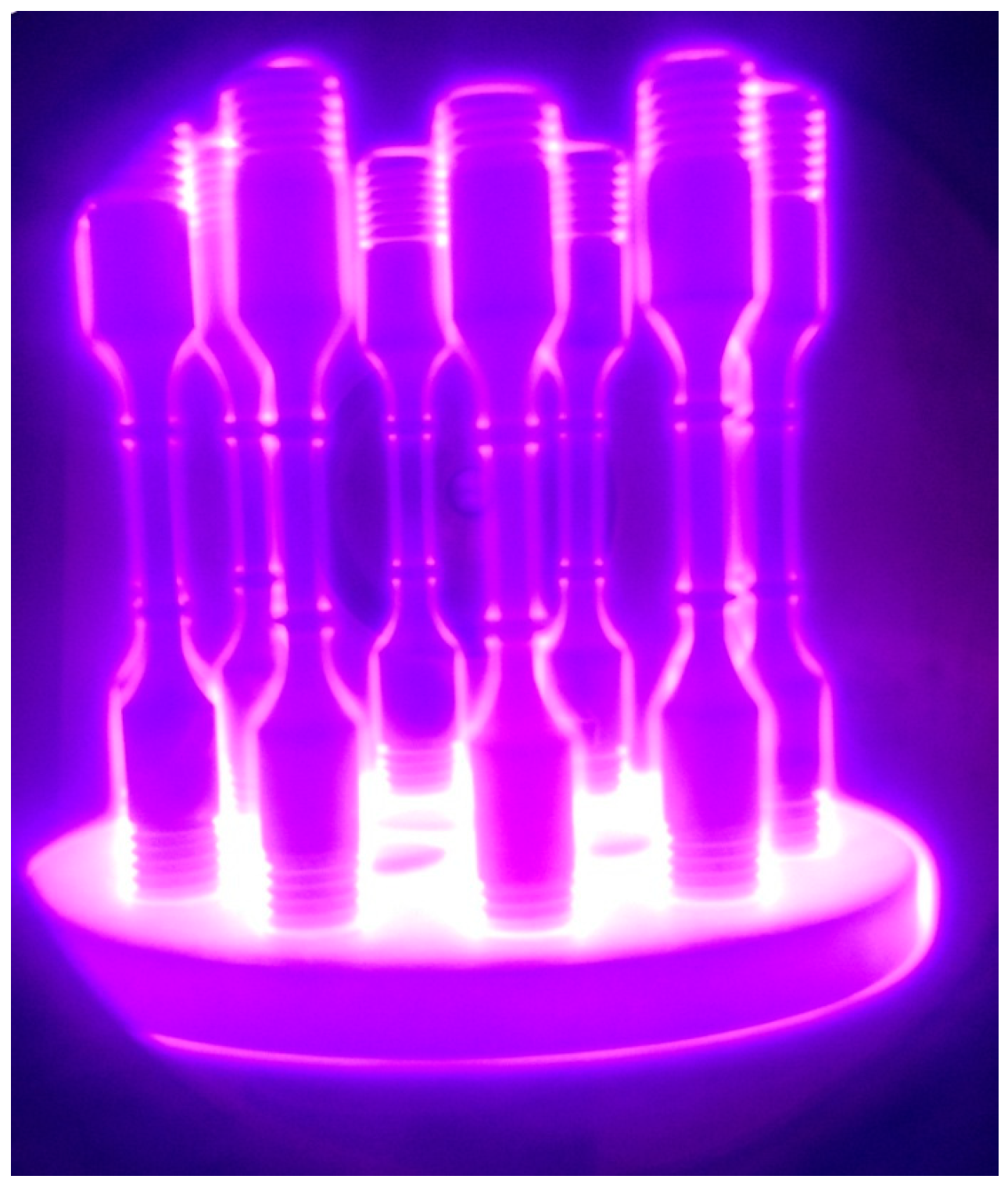
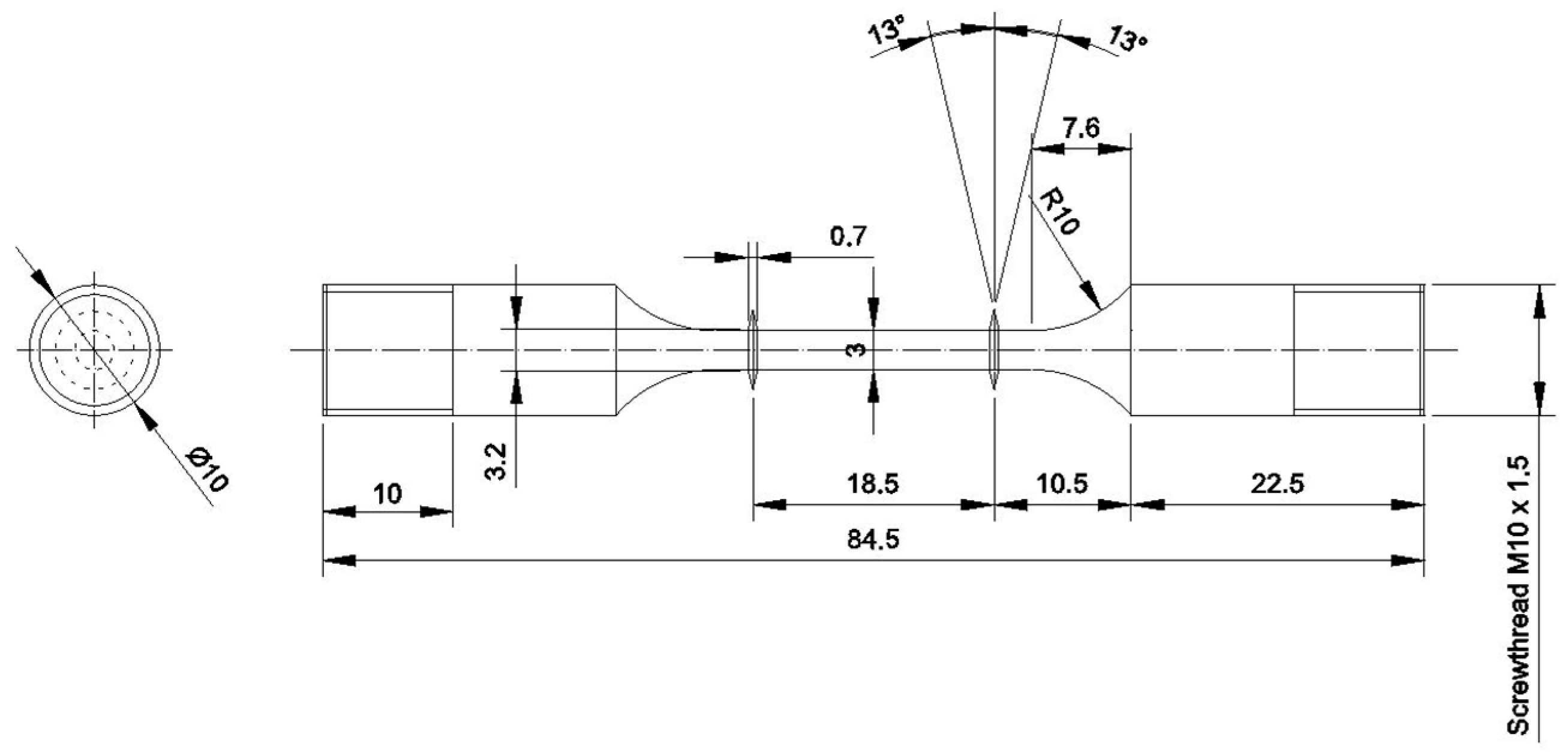

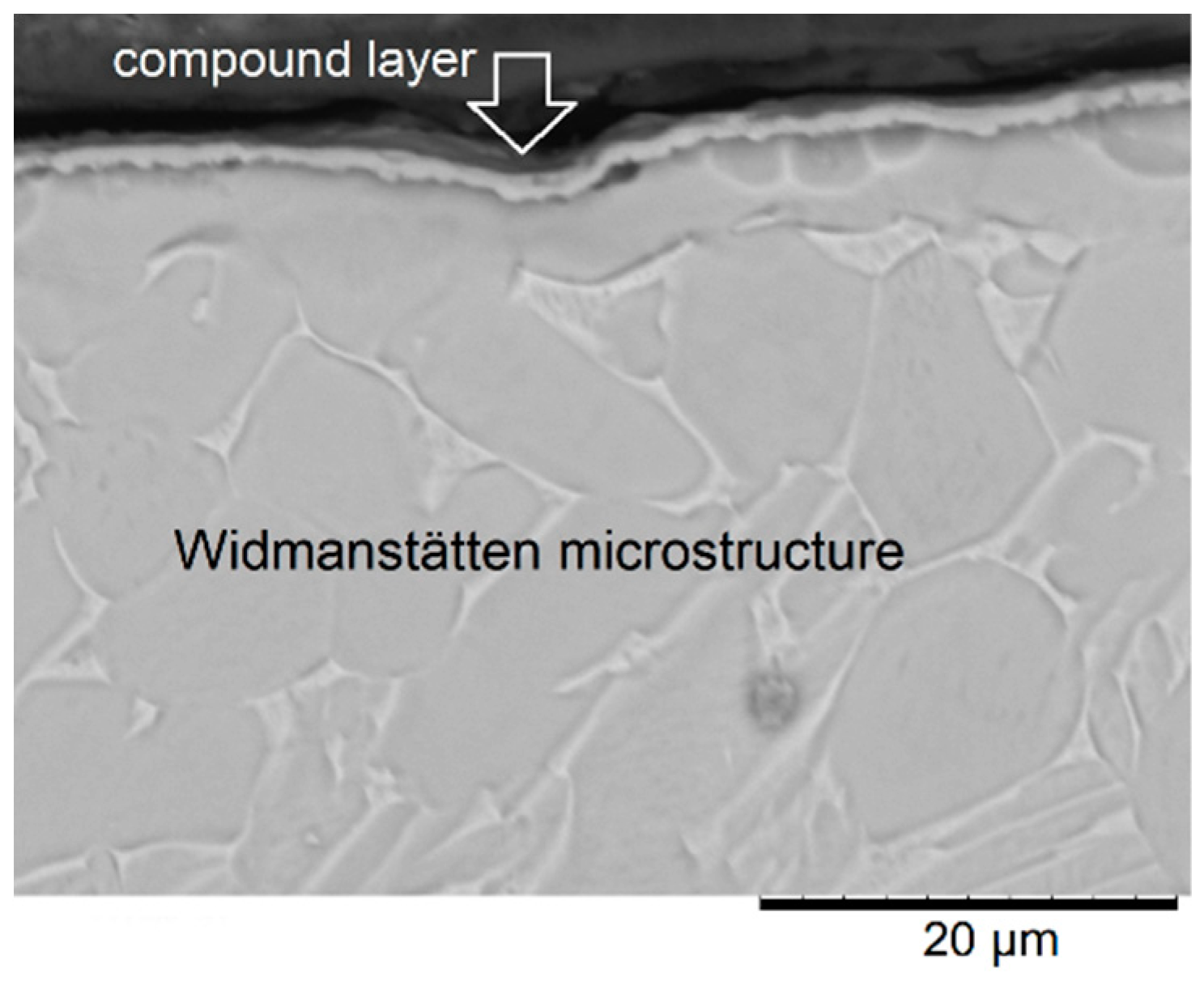

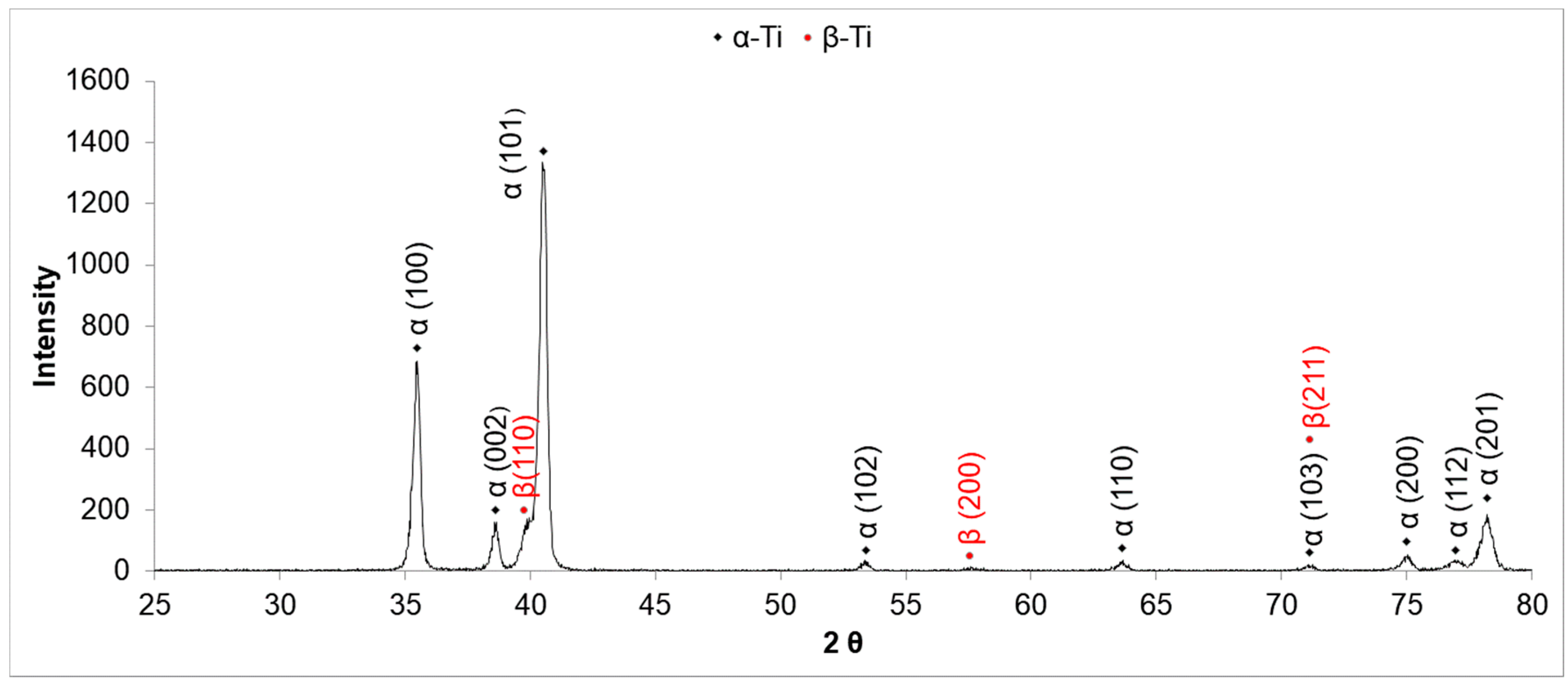
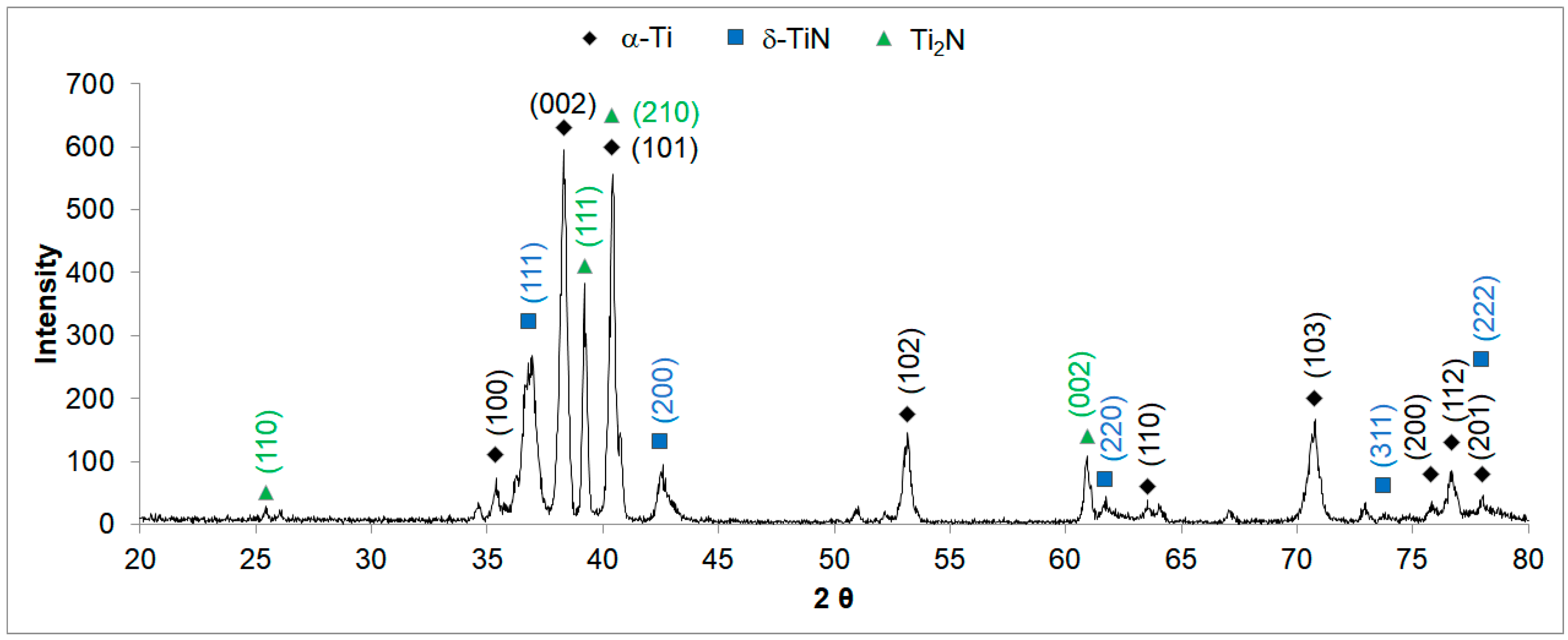




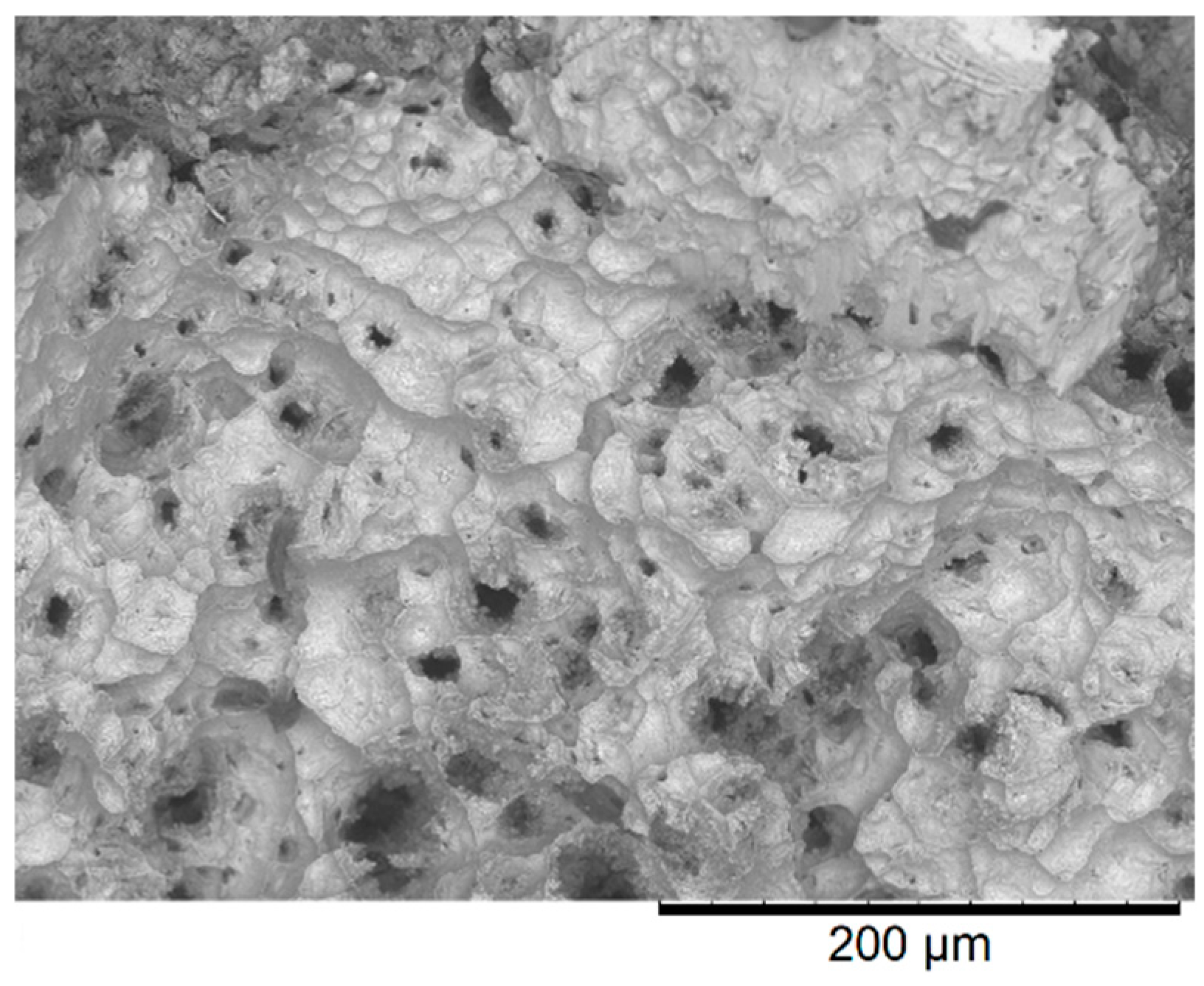

| Element | Al | V | Fe | O | N | H | C | Total Other | Ti |
|---|---|---|---|---|---|---|---|---|---|
| wt % | 5.5/6.75 | 3.5/4.5 | Max. 0.4 | Max. 0.2 | Max. 0.05 | Max. 0.125 | Max. 0.1 | Max. 0.4 | balance |
| Temperature (°C) | Condition | YS (MPa) | UTS (MPa) | EL (%) | RA (%) |
|---|---|---|---|---|---|
| 500 | untreated | 525 | 576 | 8 | 23.3 |
| plasma-nitrided | 679 | 741 | 8 | 40.4 | |
| 600 | untreated | 419 | 434 | 9 | 26.9 |
| plasma-nitrided | 532 | 587 | 10 | 22.5 | |
| 700 | untreated | 281 | 302 | 14 | 51.8 |
| plasma-nitrided | 337 | 370 | 16 | 49.0 |
| Temperature (°C) | σ (MPa) | Condition | tp (h) | tf (h) | ||
|---|---|---|---|---|---|---|
| 500 | 319 | untreated 1 | 16.000 | 0.00035 | 224.00 | 0.112 |
| plasma-nitrided | 8.300 | 0.00008 | 251.27 | 0.038 | ||
| 600 | 125 | untreated 1 | 9.000 | 0.00140 | 102.12 | 0.286 |
| plasma-nitrided | 4.000 | 0.00038 | 112.56 | 0.464 | ||
| 250 | untreated 1 | 0.350 | 0.03040 | 2.03 | 0.098 | |
| plasma-nitrided | 0.417 | 0.00367 | 6.03 | 0.031 | ||
| 319 | untreated 1 | 0.067 | 0.16000 | 0.62 | 0.237 | |
| plasma-nitrided | 0.042 | 0.02070 | 1.17 | 0.056 | ||
| 700 | 319 | untreated 1 | 0.003 | 7.54000 | 0.01 | 0.158 |
| plasma-nitrided | 0.008 | 1.08000 | 0.02 | 0.022 |
| Temperature (°C) | σ (MPa) | Relation |
|---|---|---|
| 500 | 319 | 1.12 |
| 600 | 125 | 1.10 |
| 250 | 2.97 | |
| 319 | 1.90 | |
| 700 | 319 | 1.59 |
| Reference | Condition | n | Qc (kJ/mol) |
|---|---|---|---|
| [50] | Equiaxed grain | 4.12 | 319 |
| [52] | Equiaxed grain | 3.59 | 266 |
| [35] | Equiaxed grain + plasma immersion ion implantation (PIII) | 3.23 | 282 |
| [53] | Equiaxed grain + laser nitrided | 6.46 | 261 |
| [9] | Widmanstätten + plasma carburized | 5.64 | 277 |
| [33] | Widmanstätten | 4.91 | 314 |
| [35] | Widmanstätten + plasma immersion ion implantation (PIII) | 5.12 | 301 |
| This work | Widmanstätten plasma-nitrided | 4.00 | 298 |
| References | Condition | M | C |
|---|---|---|---|
| This work | Widmanstätten microstructure (plasma-nitrided) | 0.979 | 0.025 |
| [55] | Equiaxed grain microstructure (untreated and laser nitrided) | 0.933 | 0.069 |
| [33] | Bimodal, martensitic and Widmanstätten microstructure (uncoated, and thermal barrier coating) | 1.047 | 0.082 |
| [50] | Equiaxed grain microstructure (tested in air atmosphere) | 1.090 | 0.085 |
| [51] | Equiaxed grain microstructure (tested in air and nitrogen atmosphere) | 1.102 | 0.092 |
| [33] | Widmanstätten microstructure (untreated) | 0.968 | 0.101 |
| [35] | Equiaxed grain, Widmanstätten and martensitic microstructure (plasma immersion ion implantation (PIII) treated) | 0.919 | 0.125 |
| [52] | Equiaxed grain microstructure (uncoated, metallic coating, and thermal barrier coating) | 0.967 | 0.150 |
© 2018 by the authors. Licensee MDPI, Basel, Switzerland. This article is an open access article distributed under the terms and conditions of the Creative Commons Attribution (CC BY) license (http://creativecommons.org/licenses/by/4.0/).
Share and Cite
Almeida, G.F.C.; Couto, A.A.; Reis, D.A.P.; Massi, M.; Da Silva Sobrinho, A.S.; De Lima, N.B. Effect of Plasma Nitriding on the Creep and Tensile Properties of the Ti-6Al-4V Alloy. Metals 2018, 8, 618. https://doi.org/10.3390/met8080618
Almeida GFC, Couto AA, Reis DAP, Massi M, Da Silva Sobrinho AS, De Lima NB. Effect of Plasma Nitriding on the Creep and Tensile Properties of the Ti-6Al-4V Alloy. Metals. 2018; 8(8):618. https://doi.org/10.3390/met8080618
Chicago/Turabian StyleAlmeida, Gisele F. C., Antônio A. Couto, Danieli A. P. Reis, Marcos Massi, Argemiro S. Da Silva Sobrinho, and Nelson B. De Lima. 2018. "Effect of Plasma Nitriding on the Creep and Tensile Properties of the Ti-6Al-4V Alloy" Metals 8, no. 8: 618. https://doi.org/10.3390/met8080618





